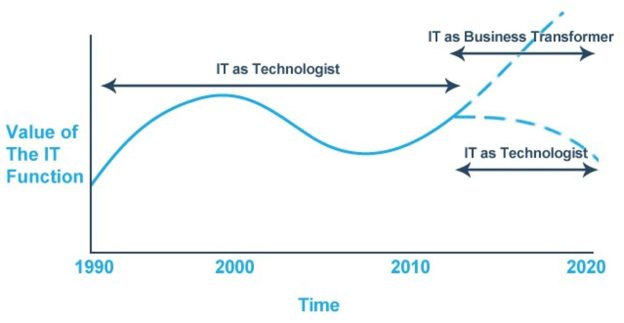May 23rd, 2016
According to a study conducted by Booz & Company, the number one reason today why CIOs are fired or let go from their position is for failure to partner with the business/organization. The next four reasons are: failing IT programs, too many service failures, excessive cost, and insufficient business impact.
What  does this mean, and how has the role of the CIO and IT changed? Over the last three decades the role of the CIO has shifted dramatically. If you looked at the qualifications for the position back then, you would see someone who had a strong IT background, naturally, and someone who was familiar and experienced with delivering IT services successfully. IT’s primary responsibility was keeping the lights on by making sure essential IT services went uninterrupted. Its primary role/function to the business was technology service provider. The graph below illustrates the value and evolution of the IT function over that time period.
does this mean, and how has the role of the CIO and IT changed? Over the last three decades the role of the CIO has shifted dramatically. If you looked at the qualifications for the position back then, you would see someone who had a strong IT background, naturally, and someone who was familiar and experienced with delivering IT services successfully. IT’s primary responsibility was keeping the lights on by making sure essential IT services went uninterrupted. Its primary role/function to the business was technology service provider. The graph below illustrates the value and evolution of the IT function over that time period.

Figure 1: Value of IT Function
Source: Info-Tech Research Group
Many things develop out of silo-based organizations, however, most of them are not positive. The characteristics and traits that do develop from these environments end up working against the organization and cost them in lost revenue, missed business opportunities, lost knowledge, and lost human capital. By not partnering with the business IT fails to understand the business, and by not understanding the business it leads to a decline in organization satisfaction with IT as a whole.
So, what is and where is the organization dissatisfied with IT? Between 2011-2013 satisfaction among executives regarding IT’s ability to meet key business objectives dropped steadily. Most notably, with respect to revenue generating objectives such as product creation and entering new markets.

Table 2: IT’s Effectiveness in Enabling Business Objectives
Source: McKinsey & Company. IT Under Pressure: McKinsey Global Survey Results
The role of the CIO today is strategic business partner first and technology specialist second. It’s essential the role demonstrates the ability to drive the organization toward their strategic goals. This means readjusting priorities for managing IT and moving more toward becoming business oriented. So, what does this really translate to?
This means the primary business role of IT is to:
- 1. Act as strategic business partner and adviser to the business
- 2. Drive new business initiatives
- 3. Improve the customer experience
- 4. Develop innovative products and services
What is standing in the way of the CIO transforming into the business partner that is now expected from the role? A shift in focus and thinking is required. First, the CIO needs to think and act like a business leader. Second, the CIO needs to align IT more toward the customer. Third, he or she needs to manage change and talent. This involves developing plans to acquire the necessary talent, and grow their IT team within the organization. How is all this accomplished? The top five success factors for CIOs today are:
- 1. Strong stakeholder management skills
- 2. Visionary and strategic thinking
- 3. Deep understanding of the business
- 4. A seat at the top management table
- 5. Oversight of all relevant resources: people, spend, etc.
If the transformation of the CIO and IT are going to be successful, they must ensure they are incorporating the factors above.
So far we’ve covered why CIOs are not successful, the transformation of the CIO role and IT function, where IT is falling short today regarding the effectiveness in enabling business objectives, and the top five areas where the CIO/IT must focus to ensure a successful business partnership with the organization.
With this critical information now at hand where does the CIO go from here, and how do they know their strategic compass is pointing true North? As a C-level IT executive now working with the business, the most important business stakeholder is the CEO. Confirming the CIO and CEO are both in alignment with the strategic direction is critical to success.
Southeast Technologies works with CIOs in this area to ensure proper IT-business alignment. Let us partner with you by taking part in our CEO-CIO Alignment Program. This assessment will provide you insights on:
- Understanding the CEO’s perception of and vision of IT for your business
- Creating a plan to address alignment gaps impeding business growth
- Identifying and building core IT processes that automate IT business alignment
- Delivering your plan to demonstrate IT value and progress.
The program will zero in on exactly what and where IT priorities need to be and offers a roadmap to the benefits that come with alignment.
For more information on this program and others please contact us today!
